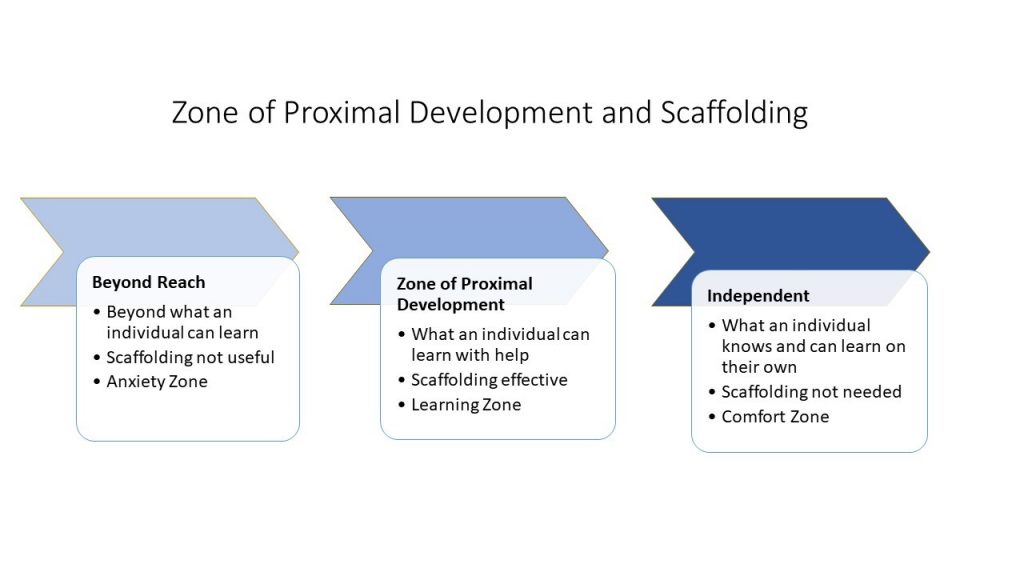10.2 Sociocultural Influences on Cognitive Development
Learning Objectives
- Describe and evaluate Vygotsky’s Socio-cultural theory.
The sociocultural view emphasizes that cognitive development is influenced by the social interactions of the child and the social and cultural context in which those interactions occur. Lev Semenovich Vygotsky (1896-1934) provided founding work in this area. Although he wrote in the early 1900s, his work did not become influential in the United States in the 1960s after his work was translated to English. By emphasizing that development occurs within the context of social interactions, Vygotsky expressed that conditions differ among children and so there will be differences in their development. In his view, there are elemental processes, such as attention and perception, which are basic processes that humans share with animals. Higher processes, however, he viewed as unique to humans. These processes are influenced by social interactions and culture. Major themes that emerge in Vygotsky’s work are that cognitive development occurs in social interaction and that psychological functioning is mediated by cultural tools.
Vygotsky proposed that as children learn, the task or concept becomes more internalized. To describe how this process occurs, we can consider Vygotsky’s concept of the zone of proximal development (ZPD; see Figure 10.2). The ZPD is the level of development at which a child can be successful with guidance of a more skilled individual. This is the zone where a child can learn new concepts and information. For example, a child may not yet be able to put three differently sized bottles in size order. With cues from a parent, the child successfully completes the task. The cues can be verbal, gestural, or occur through modeling. Vygotsky called the providing of such cues scaffolding. Children learn best when learning opportunities are presented within their ZPD and scaffolding is present.

Long Description
Description of the image
Title: Vygotsky’s Zone of Proximal Development and Scaffolding
Zone of Proximal Development and Scaffolding:
3 arrows underneath title pointing to the right with boxes describing the stages:
- Beyond Reach
- Beyond what an individual can learn
- Scaffolding not useful
- Anxiety zone
- Zone of Proximal Development
- What an individual can learn with help
- Scaffolding effective
- Learning Zone
- Independent
- What an individual knows and can learn on their own
- Scaffolding not needed
- Comfort zone
Link to Learning
A brief introduction to Vgotsky’s theory
Look for examples of zone of proximal distance and scaffolding.
Vygotsky ‘s theory extended to how children learn culture. Culture is transmitted by parents and the community to the child. Unlike Piaget’s theory which emphasizes self-initiated discovery, Vygotsky emphasized that learning is socially constructed. There are many ways that learning occurs socially. Many modern psychologists have built on Vygotsky’s theory to investigate ways in which children learn socially (summarized by Bjorklund & Causey, 2018). One type of learning is shared remembering. Groups or pairs of individuals work together to remember information or an event. Children can learn strategies for remembering as their parents prompt them with cues. They may learn about their culture and values as their parents select information to repeat and remember significant events. Guided participation (Rogoff et al., 1993), another form of social learning, is an activity where individuals share an experience where a skilled individual shares knowledge of the activity. The instruction can be through a routine behavior, e.g., baking a favorite holiday food together, or may involve explicit instruction, e.g., a parent explaining and demonstrating to a child how to fix a flat bicycle tire. Culture can influence the form that guided participation takes. For example, Mejia et al. (2012) compared children from a background of Indigenous Mexican history with children with a European-American middle-class background on the use the balance of verbal and nonverbal conversations as children learned a new task, folding origami figures. They found that the children with Indigenous histories had more equally proportional use of nonverbal conversations and verbal discussion about the folding while they were folding the origami. In contrast, the European-American children used predominantly verbal communication. This supported the idea that children learned cultural patterns of communication through their social interactions.
Exercises
Test your knowledge:
In Vygotsky’s theory of socio-cultural development, the zone of proximal distance is the difference between the child’s current performance or ability and their performance with guidance by a more skilled individual.
A teacher or more advanced peer provides support and guidance to a less skilled individual to increase their understanding and performance.
